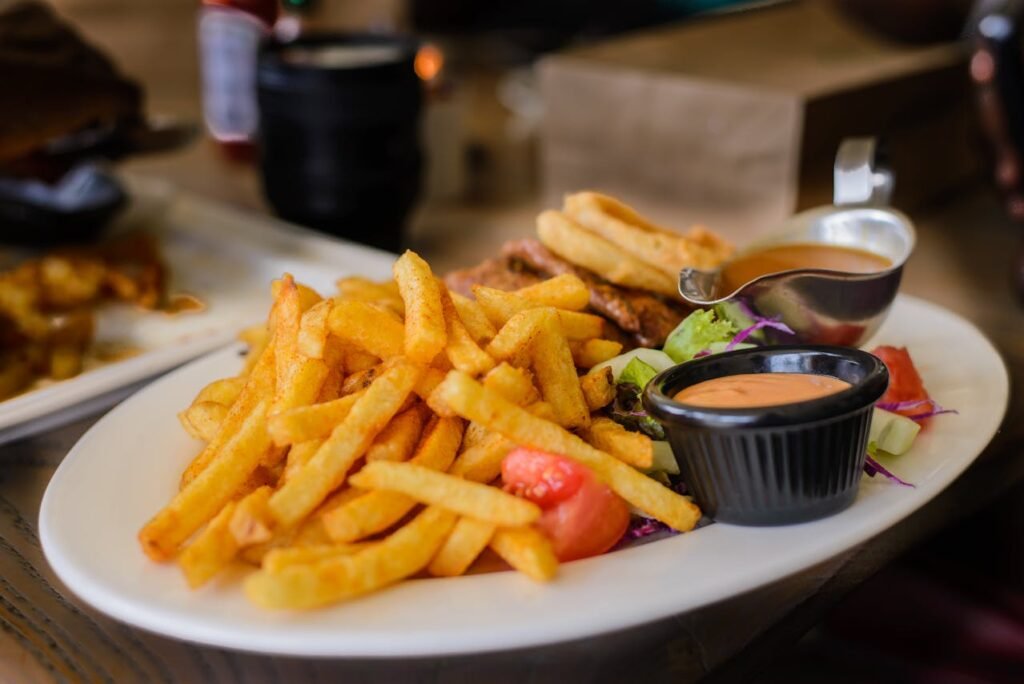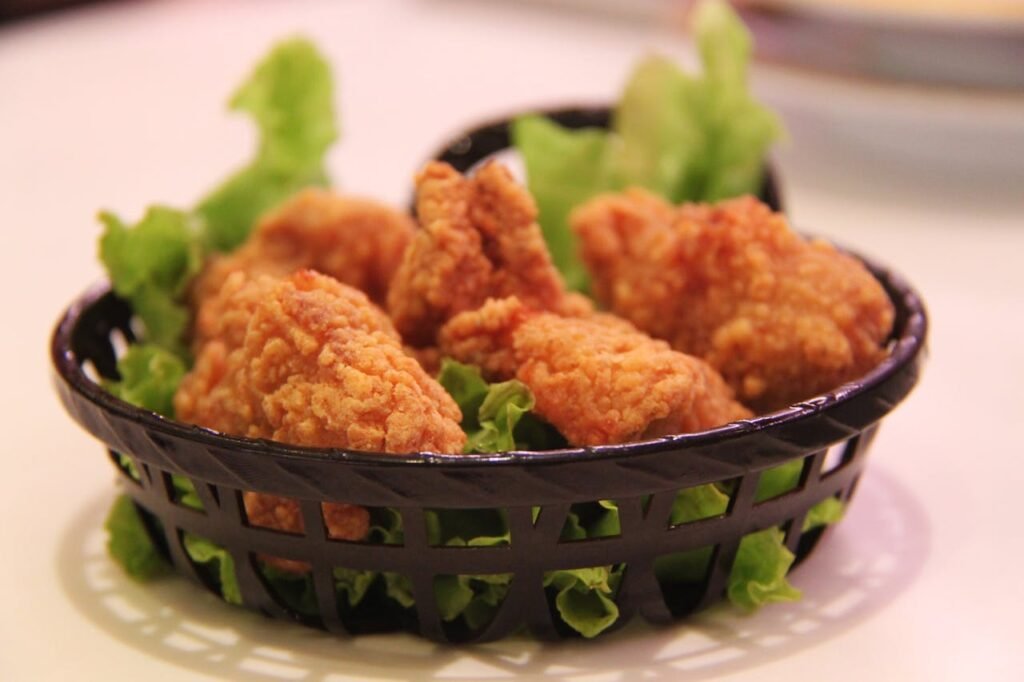Types of Fries You Can Make at Home: Beyond the Basic French Fry

Types of fries you can make at home go far beyond basic french fries. From classic cuts like shoestring, steak fries, and crinkle-cut to specialty shapes like curly fries and tornado potatoes, the possibilities are endless. Explore healthier alternatives with sweet potato, carrot, and courgette fries, each offering unique flavours and nutritional benefits. Master cooking techniques from double-frying to air-frying for perfect crispiness every time. Elevate your fries with creative seasonings like garlic-chive, spicy Cajun, or truffle Parmesan, and pair them with homemade dipping sauces from garlic aioli to curry yoghurt. With the right techniques and tools, you can create restaurant-quality fries tailored to any preference or dietary need.
Introduction to Homemade Fries
Types of fries you can make at home extend far beyond the standard chip you might pick up from your local takeaway. The humble potato has incredible versatility, transforming into countless crispy variations that can elevate your home cooking to restaurant quality. Whether you’re hosting a weekend gathering or simply craving something more exciting than basic french fries, exploring different types of homemade fries can revolutionise your culinary repertoire.
- Making fries at home allows you complete control over ingredients, cooking methods, and flavour profiles.
- You can adjust the thickness, choose healthier cooking options, experiment with seasonings, and even explore alternative vegetables beyond potatoes.
- The beauty of homemade fries lies in this flexibility and the satisfaction of creating something truly delicious from scratch.
In this comprehensive guide, we’ll explore various types of fries you can easily prepare in your own kitchen, from classic cuts with special techniques to exotic variations that will impress even the most discerning palate. We’ll cover everything from the perfect cutting methods to cooking techniques that ensure maximum crispiness. You’ll discover that making different types of fries at home isn’t just possible—it’s surprisingly straightforward with the right approach.
So put away those frozen bags and prepare to elevate your fry game. With these techniques and recipes, you’ll master the art of homemade fries that are crispy on the outside, fluffy on the inside, and bursting with flavour. Types of fries you can make at home are limited only by your imagination, so let’s begin this delicious journey beyond the basic french fry.

Classic Cut Variations of Homemade Fries
Types of fries you can make at home start with mastering the classic cuts that form the foundation of fry-making. Each cut offers a different texture and cooking experience, allowing you to customise your fries based on personal preference. The way you slice your potatoes significantly impacts the final result, affecting everything from cooking time to crispiness.
- Shoestring Fries: These ultra-thin fries are the crispy fry lover’s dream.
- Cut into matchstick-thin strips approximately 1/8 inch thick
- Cook quickly and deliver maximum crispiness with minimal interior fluffiness
- Perfect for those who prioritise crunch over potato flavour
- Use a mandoline slicer for consistent thickness
- Fry them for just 1-2 minutes until golden brown
- Steak Fries: On the opposite end of the spectrum, steak fries are thick, hearty wedges.
- Cut into wedges about 1/2 inch thick
- Showcase the potato’s fluffy interior
- Pair perfectly with robust mains like steaks and burgers
- Require longer cooking times
- Reward patience with a satisfying contrast between crisp exterior and pillowy interior
- Crinkle-Cut Fries: A favourite among children and adults alike.
- Feature distinctive ridges that increase surface area for enhanced crispiness
- Excel at holding sauces and seasonings
- Can be made at home with a crinkle cutter or mandoline with a fluted blade
- Create fries that are “shorter than the standard fry”
- Offer “ridges that make picking up ketchup or other sauces easier”
- Waffle Fries: These lattice-patterned fries create a distinctive appearance.
- Created by quarter-turning the potato before each slice over a specialised grater
- Maximise crispiness while retaining enough thickness for a fluffy interior
- Ideal for dipping and holding toppings
- Can be created using a mandoline with a waffle cutting attachment
- Cottage Fries: Popular in steakhouses across America.
- Round-cut with distinctive ridges
- Offer “a super fluffy interior when cooked correctly”
- Maintain crispiness on the outside
- Coin-like shape makes them perfect for even cooking and consistent texture
Mastering these classic cuts gives you a solid foundation for exploring the world of homemade fries. Each type offers unique advantages in terms of texture, cooking time, and flavour delivery. Types of fries you can make at home begin with these fundamental variations, but the possibilities extend much further as we’ll see in the following sections.
Spiral and Specialty Shaped Fries
Types of fries you can make at home include fascinating spiral and specialty shapes that transform the humble potato into works of culinary art. These visually striking variations not only look impressive on the plate but also offer unique textural experiences that standard fries simply can’t match.
- Curly Fries: These spiralized potatoes are perhaps the most recognizable specialty fry.
- Require a spiralizer fitted with a 1/4-inch blade
- Begin by trimming the potato to fit your spiralizer
- Crank it through to create distinctive spirals
- For authentic restaurant-quality, use a batter coating
- Mix flour with paprika, cayenne, garlic powder, onion powder, salt, and pepper
- Add water to create a smooth batter
- Dredge spiralized potatoes in this mixture before frying
- Tornado Fries: Taking the spiral concept even further.
- Helical-cut potatoes placed on skewers before deep frying
- A Korean street food favourite with dramatic presentation
- Offer a perfect balance of crispy edges and tender potato
- To make at home, skewer a whole potato
- Carefully cut around it in a spiral pattern while rotating the skewer
- Creates an impressive spiral that stretches the length of the potato
- Potato Ribbons: These delicate, ribbon-like fries offer an elegant alternative.
- Created using a vegetable peeler to make long, thin strips
- Fry quickly and deliver exceptional crispiness due to minimal thickness
- Perfect for gourmet presentations and lighter meals
- Delicate nature makes them visually appealing
- Basket-Weave Fries: For the ambitious home cook.
- Represent the pinnacle of fry artistry
- Created by carefully arranging thin potato slices in an overlapping pattern
- Form a basket-like structure that’s functional and beautiful
- Woven pattern creates pockets perfect for holding sauces or toppings
- Hasselback Fries: Inspired by the famous Swedish potato preparation.
- Created by making thin, parallel cuts almost—but not quite—through the potato
- When fried or baked, cuts fan out to create a series of crispy edges
- Maintain a connected base for easy handling
- Offer a unique textural experience with maximized surface area for seasoning
These specialty shapes demonstrate that types of fries you can make at home can be elevated from simple side dishes to conversation-starting culinary creations. While they may require special tools or techniques, the impressive results make them well worth the extra effort for special occasions or when you’re looking to elevate your fry game beyond the ordinary.
Sweet Potato and Alternative Vegetable Fries
Types of fries you can make at home extend well beyond traditional potatoes, with sweet potatoes and other vegetables offering nutritious and flavourful alternatives. These variations provide different nutritional profiles, unique flavours, and exciting colours that can transform your plate while satisfying cravings for crispy, dippable treats.
- Sweet Potato Fries: Perhaps the most popular potato alternative.
- Offer a naturally sweeter flavour profile and vibrant orange colour
- Nutritionally superior to regular potatoes
- Contain more fibre, vitamins A and C, and antioxidants
- Preparation tips:
- “Slice your sweet potatoes into long, thin strips, about 1/4-inch wide”
- “Soak for at least 30 minutes” in cold water to remove excess starch
- Dry thoroughly, toss with olive oil and a mixture of cornstarch, garlic powder, smoked paprika, and black pepper
- Cornstarch is crucial for achieving crispiness due to higher moisture content
- Carrot Fries: These vibrant orange sticks offer impressive nutritional benefits.
- Rich in beta-carotene and fibre
- Provide sweet, earthy flavour
- Best results:
- Cut carrots into uniform sticks
- Toss with olive oil and seasonings like cumin or coriander
- Roast at a high temperature until edges caramelise
- Natural sugars create delightful sweetness when roasted properly
- Parsnip Fries: With subtle sweetness and nutty undertones.
- Offer a sophisticated alternative to potato-based options
- Contain more fibre than potatoes
- Develop wonderful caramelised exterior when roasted
- Preparation:
- Cut into uniform sticks
- Toss with olive oil, rosemary, and a touch of honey
- Roast until golden for a gourmet side dish
- Courgette Fries: For a lower-carb option.
- Provide a tender interior with a crispy coating
- Key to crispiness lies in the coating due to high moisture content
- Preparation method:
- Dredge courgette sticks in beaten egg
- Coat in a mixture of breadcrumbs, Parmesan, and Italian herbs
- Bake or air-fry until golden
- Root Vegetable Medley: Combine multiple vegetables for variety.
- Mix beetroot, turnips, celeriac, and other root vegetables
- Creates a colourful, nutritionally diverse fry medley
- Each vegetable contributes unique flavours and textures
- Preparation tips:
- Cut all vegetables to the same size for even cooking
- Toss with olive oil and herbs
- Roast until caramelised and tender
These alternative fries demonstrate that types of fries you can make at home can be both delicious and nutritious. They offer exciting ways to incorporate more vegetables into your diet while satisfying cravings for crispy, flavourful sides. Whether you’re looking to reduce carbohydrates, increase nutrients, or simply explore new flavours, these vegetable alternatives provide delicious options beyond the basic french fry.
Cooking Techniques for Perfect Homemade Fries
Types of fries you can make at home achieve their ultimate potential through proper cooking techniques. The method you choose significantly impacts texture, flavour, and nutritional profile. Mastering these techniques allows you to create restaurant-quality fries tailored to your dietary preferences and equipment availability.
- Double-Frying Method: This professional technique is the secret to exceptionally crispy exteriors.
- “The trick to achieving the perfect fry is to fry them twice”
- First frying:
- Lower temperature (250°F to 275°F)
- Cooks the interior and removes moisture
- “Blanches the fries and makes them softer and fluffier inside”
- Second frying:
- Higher heat (around 350°F)
- Creates golden, crispy exterior
- “Transforms potatoes into perfectly golden, crispy fries”
- Allow fries to cool completely between fryings for best results
- Oven-Baked Fries: For a healthier alternative that still delivers on crispiness.
- Uses significantly less oil than deep frying
- Key techniques:
- Proper spacing—”Be sure that the fries aren’t overlapping, or else they will not cook evenly”
- Flipping halfway through cooking
- Preheating your baking sheet creates immediate searing
- Soak cut potatoes in cold water first to remove excess starch
- Dry thoroughly before tossing with oil
- Air Fryer Fries: The air fryer has revolutionised homemade fry-making.
- Offers crispy results with minimal oil
- Circulates hot air around food for crispy exterior
- Uses up to 80% less fat than deep-frying
- Best practices:
- Avoid overcrowding the basket
- Toss cut potatoes with just 1-2 tablespoons of oil
- Shake the basket occasionally during cooking for even browning
- Cold Water Soak: A crucial preparatory step regardless of cooking method.
- Removes excess starch from the surface
- Prevents fries from sticking together
- Promotes crispiness
- “Soak the potatoes in cold water for 15 to 30 minutes (the longer the better)”
- Makes potato cells firmer, leading to crispier fries
- Thoroughly dry potatoes after soaking to prevent oil splatter and ensure proper browning
- Serrated Knife Technique: A simple but effective trick.
- Use a serrated knife to cut your potatoes
- “Though not visible to the eye, it makes the surface rougher”
- Creates more surface area to crisp up
- Results in crispier fries
- Works with any cooking method
- Requires no special equipment beyond a serrated knife
These cooking techniques demonstrate that types of fries you can make at home can rival or exceed restaurant quality when prepared properly. By understanding the science behind each method and applying these professional techniques, you can create perfectly crispy, flavourful fries tailored to your preferences and dietary needs.

Seasoning and Flavour Variations for Homemade Fries
Types of fries you can make at home reach their full potential through creative seasoning and flavour combinations. While perfectly cooked fries are delicious on their own, thoughtful seasoning transforms them from simple sides to memorable culinary experiences. Exploring different flavour profiles allows you to customise your fries to complement any meal or satisfy specific cravings.
- Classic Seasoned Fries: For a timeless flavour profile.
- Combines salt, pepper, garlic powder, and paprika
- Enhances the potato’s natural taste
- Works with any type of fry and cooking method
- Best application:
- Toss fries in seasoning immediately after cooking
- Apply while still hot and slightly oily
- Allows seasonings to adhere perfectly
- Garlic-Chive Fries: Elevate your fries with aromatic flavours.
- After cooking, toss hot fries with:
- Minced garlic
- Finely chopped chives
- Sprinkle of Parmesan cheese
- Residual heat gently cooks the garlic
- Releases flavour without bitterness of raw garlic
- Pairs beautifully with grilled meats
- Works as an upscale appetiser
- After cooking, toss hot fries with:
- Spicy Cajun Fries: For heat lovers seeking bold flavour.
- Combine paprika, cayenne pepper, garlic powder, onion powder, dried oregano, and thyme
- Creates an authentic Cajun profile
- Apply generously for spicy kick
- Pairs perfectly with cooling dips like ranch or blue cheese dressing
- Truffle Parmesan Fries: Create a gourmet experience.
- Toss hot fries with:
- Truffle oil
- Grated Parmesan cheese
- Finely chopped parsley
- Earthy aroma of truffle combines with salty richness of Parmesan
- Transforms simple fries into sophisticated side
- Use sparingly as truffle flavour can be quite powerful
- Toss hot fries with:
- Curry-Spiced Sweet Potato Fries: Sweet-savoury combination.
- Toss sweet potato fries with:
- Curry powder
- Pinch of cinnamon
- Touch of brown sugar
- Complements natural sweetness of potatoes
- Adds aromatic depth
- Warming spices make this variation appealing during colder months
- Toss sweet potato fries with:
- Loaded Waffle Fries: Transform fries into a satisfying snack or appetiser.
- “Make any dinner fun with Loaded Waffle Fries, topped with a savory blend of cheese, scallions and bacon”
- Preparation:
- Arrange cooked waffle fries on baking sheet
- Sprinkle with shredded cheddar cheese and bacon bits
- Return to oven briefly until cheese melts
- Finish with chopped green onions for freshness and colour
These flavour variations demonstrate that types of fries you can make at home can be endlessly customised to suit any palate or occasion. By experimenting with different seasoning combinations, you can create signature fry recipes that reflect your personal taste preferences while complementing your main dishes perfectly.
Dipping Sauces to Complement Your Homemade Fries
Types of fries you can make at home deserve equally impressive dipping companions. While ketchup remains the classic choice, exploring homemade dipping sauces elevates the entire fry experience. Creating your own sauces allows you to control ingredients, adjust flavours to your preference, and impress guests with unique pairings tailored to specific fry variations.
- Garlic Aioli: A sophisticated upgrade to plain mayonnaise.
- Combines:
- Mayonnaise
- Freshly minced garlic
- Lemon juice
- Touch of Dijon mustard
- Creates a creamy, flavourful dip
- Complements both regular and sweet potato fries
- For extra complexity, add finely chopped herbs like parsley or dill
- Combines:
- Spicy Sriracha Mayo: Perfect balance of creaminess and spice.
- Mix:
- Mayonnaise
- Sriracha sauce to desired heat level
- Splash of lime juice
- Pinch of sugar to round out flavours
- Works particularly well with:
- Crispy shoestring fries
- Waffle fries
- Mix:
- Truffle Ketchup: Elevate the classic condiment.
- Stir a few drops of truffle oil into good-quality ketchup
- Transforms everyday sauce into something special
- Adds earthy undertones that complement potato’s natural flavour
- Pair with:
- Thicker cut fries like steak fries
- Cottage fries
- Curry Yoghurt Dip: Cooling counterpoint to spicy fries.
- Combine:
- Greek yoghurt
- Curry powder
- Touch of honey
- Finely chopped cucumber
- Creates refreshing dip that balances heat beautifully
- Pairs exceptionally well with:
- Sweet potato fries
- Fries seasoned with warming spices
- Combine:
- Blue Cheese Dressing: Rich and tangy option for sophisticated palates.
- Offers satisfying contrast to fries’ crunch
- Homemade version combines:
- Sour cream
- Mayonnaise
- Crumbled blue cheese
- Splash of vinegar
- Freshly ground black pepper
- Best with shoestring fries and other crispy varieties
- Honey Mustard: Sweet-tangy sauce for addictive flavour combination.
- Mix:
- Equal parts Dijon mustard and honey
- Splash of apple cider vinegar
- Pinch of cayenne for complexity
- Offers perfect balance of sweetness, acidity, and subtle heat
- Works with both regular and sweet potato fries
- Mix:
These dipping sauces demonstrate that types of fries you can make at home deserve thoughtfully crafted accompaniments. By pairing specific sauces with complementary fry varieties, you create a cohesive flavour experience that elevates your homemade fries from simple sides to memorable culinary creations.
Comparison of Different Types of Homemade Fries
Types of fries you can make at home vary significantly in texture, flavour, preparation difficulty, and cooking time. Understanding these differences helps you choose the right fry for your specific occasion, equipment availability, and skill level. This comparison provides a comprehensive overview to guide your homemade fry adventures.
| Fry Type | Texture | Prep Difficulty | Cooking Time | Best Cooking Method | Special Equipment |
|---|---|---|---|---|---|
| Shoestring | Very crispy, minimal fluffiness | Medium | 1-2 minutes | Deep frying | Mandoline slicer |
| Steak Fries | Crisp exterior, very fluffy interior | Easy | 20-25 minutes | Oven baking or deep frying | None |
| Crinkle-Cut | Moderately crispy with ridges | Medium | 3-4 minutes | Deep frying | Crinkle cutter |
| Waffle Fries | Crispy lattice pattern | High | 3-5 minutes | Deep frying | Waffle c |


